
Mystic Quartz Gem: Properties, Meanings & Price Information
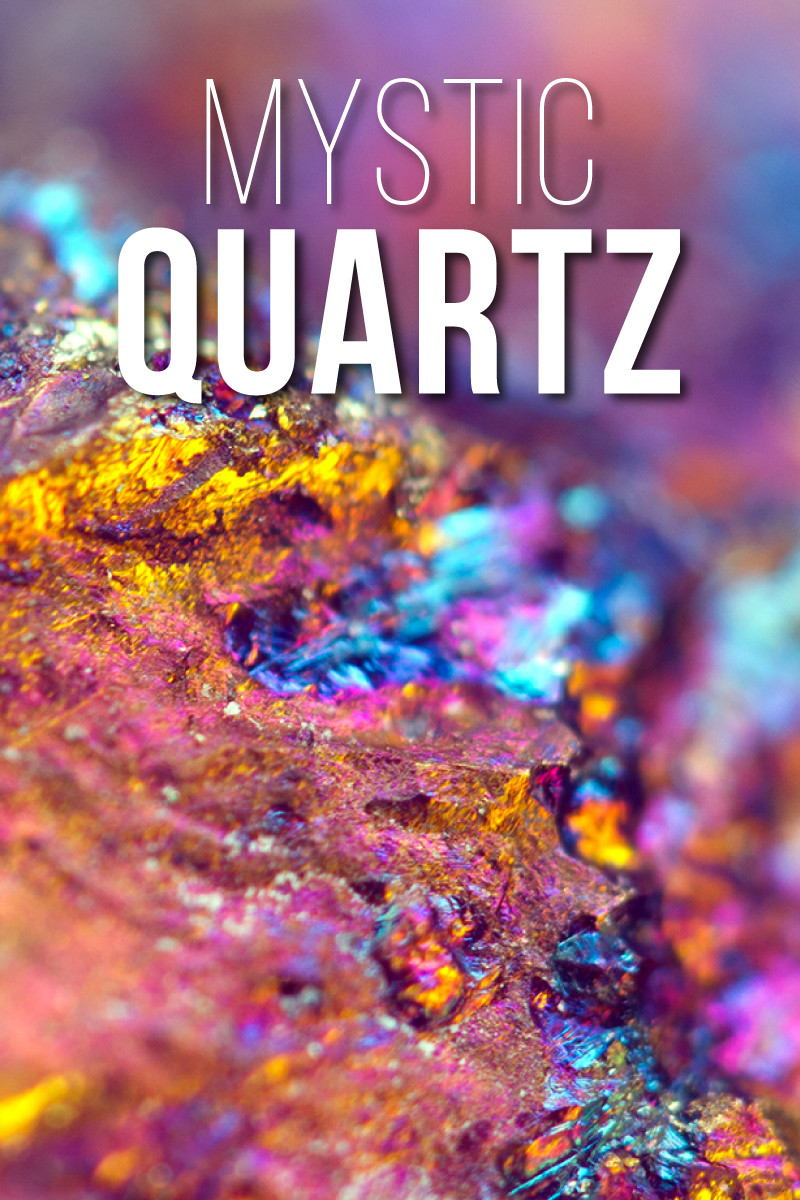 Mystic quartz is a radiant type of quartz gemstone treated with a surface coating to display an iridescent or kaleidoscopic rainbow of colors. Similar gems are treated this way, like mystic topaz and recently mystic moissanite.
Mystic quartz is a radiant type of quartz gemstone treated with a surface coating to display an iridescent or kaleidoscopic rainbow of colors. Similar gems are treated this way, like mystic topaz and recently mystic moissanite.
But what is a mystic gemstone? A “mystic gemstone” usually refers to a gem treated with an Azotic® or Mystic® process, both of which are trademarked by Azotic LLC.
Is mystic quartz natural? Yes and no. The base stone is usually a natural clear quartz, but the signature coloring comes from a lab-induced treatment. However, synthetic quartz stones can also be used.
Interested in rocking a mystic quartz ring? Come along to learn all about mystic quartz’s properties, benefits, prices, and care guidelines to prepare before you buy!
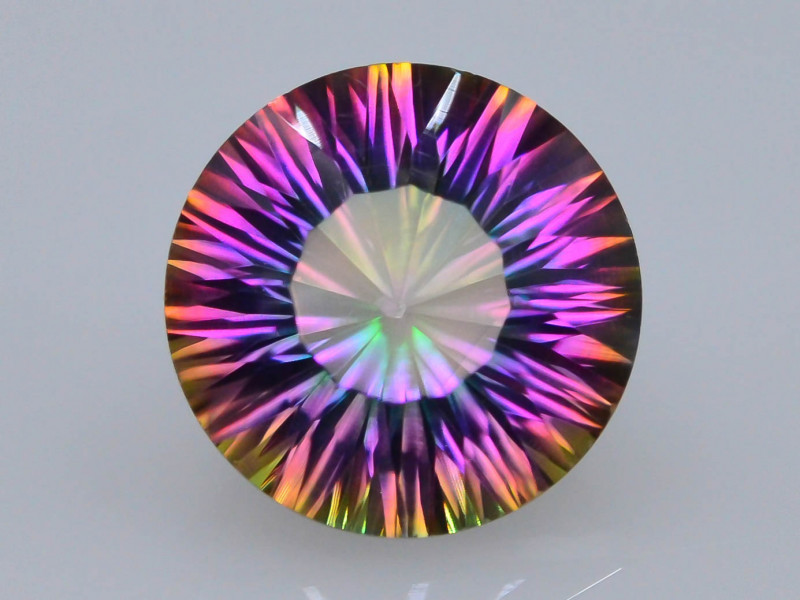
What Is Mystic Quartz?
Mystic quartz is a semi-precious gemstone that reflects a kaleidoscopic rainbow of colors. The gem is a zodiac stone for all signs and an April birthstone. You can also substitute it for the quartz stone amethyst as a February birthstone.
Additional names for mystic quartz include:
Aqua Aura / Aqua Aura Quartz
Aura Quartz
Flame Aura Quartz
Opal Aura Quartz
Titanium Quartz
Some of the names listed refer to slightly different varieties, which we’ll cover in a bit.
Another name you’ll see pop up in discussion about mystic quartz is mystic topaz. But what is the difference between mystic topaz and mystic quartz?
Mystic quartz and mystic topaz are both colorless, natural gems treated with a surface coating to result in a similar iridescent look. The difference is the base stone used — mystic quartz starts with natural clear quartz, while mystic topaz starts with natural, clear topaz. Therefore, the stones are distinguished by the inherent differences between quartz and topaz.
Mystic Quartz Specifications & Characteristics
Mystic quartz starts as clear quartz, a silicon dioxide mineral with the formula SiO2. There are numerous types of quartz, both macrocrystalline like clear quartz (with distinguished, visible crystals) and microcrystalline like chalcedony (with compact, tiny crystals only visible under magnification.)
Some macrocrystalline varieties you may know are rose quartz, amethyst, citrine, and smoky quartz. Popular chalcedony (microcrystalline quartz) varieties are agate, jasper, carnelian, and onyx.
Unlike mystic quartz, most of the varieties listed above get their color naturally from impurities present during their formation. However, many quartz and chalcedony stones are treated. For example, most citrine is heat-treated amethyst, and almost every solid-colored black onyx has been dyed.
Back to clear quartz, the stone usually forms as six-sided prism crystals with six-sided pyramids at the ends. It can also form as masses or druzy.
Here are the mineral properties of mystic quartz:
Color: Iridescence displays entire rainbow spectrum, usually blue, purple, and green shades dominant
Crystal structure: Trigonal
Luster: Vitreous (glassy)
Transparency: Transparent to translucent
Refractive index: 1.544 - 1.553
Density: 2.65
Cleavage: None
Fracture: Conchoidal
Streak: White
Luminescence: None
Pleochroism: None
Birefringence: 0.009
We’ve mentioned rainbow-like iridescence, but that’s just one type of mystic quartz.

Types of Mystic Quartz
What does a mystic stone look like? It depends on the mystic stone. Azotic LLC produces quite a few different surface-enhanced stones, some called “mystic” and some with other names.
Some varieties of mystic quartz with different appearances include:
Pearl Aura Quartz: Platinum-coated quartz with light pink iridescent sheen
Blue Flame Aura Quartz: Titanium- and niobium-coated quartz with vibrant blue sheen
Mystic Fire® Green Quartz: Coated quartz with predominantly green, blue, and pink or purple sheen
Northern Lights™ Quartz or Aurora Borealis Quartz: Coated quartz with multiple colors resembling Aurora Borealis (the Northern Lights), predominantly pink or purple and green
What about azotic quartz? The difference between mystic quartz and azotic quartz can be confusing, but they’re often used interchangeably.
“Azotic” refers to the patented surface coating process (created by Azotic LLC) used to treat these stones. That said, some azotic quartz or azotic topaz gems may be more pinkish-yellow than their mystic counterparts.
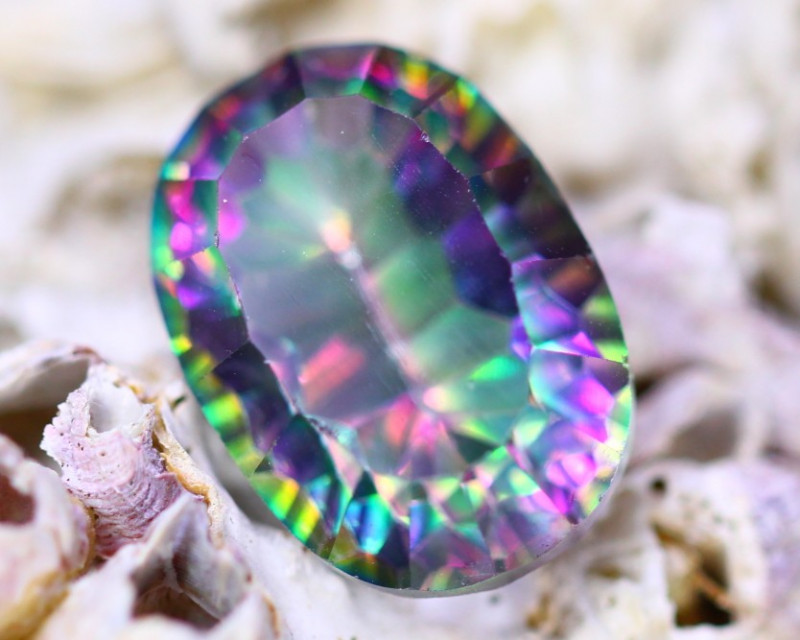
Mystic Quartz Meaning & History
Mystic quartz’s spiritual meaning ties to the symbolism of clear quartz and rainbows. Clear quartz symbolizes spiritual growth, light, and clarity. Rainbows represent hope, inclusivity, and peace.
As you know now, mystic quartz and azotic quartz are patented by Azotic LLC. The name “azotic” comes from the French azote, meaning “nitrogen-containing.” Mystic quartz is treated with titanium, not nitrogen, but the company coats materials with all types of metals, oxides, and other substances.
The Azotic LLC company started as Azotic Coating Technology. It was founded in 1993 by vacuum and materials professionals based in Rochester, Minnesota, USA.
The first mystic stone was mystic topaz, created in 1996 and introduced in 1998 at the Hong Kong Jewelry Fair. Though public knowledge of the new stones took a while to gain momentum, eventually these gems shot into popularity and new mystic gems were introduced.
In fact, Azotic LLC enhanced over 30 million carats of quartz, topaz, and cubic zirconia between 2004 and 2005. They are still coming out with new options, like their latest line of Mystic® Moissanite gems created using their Fantasia™ Process.
Besides being fashionable and mesmerizing, what do mystic quartz stones do in terms of healing?
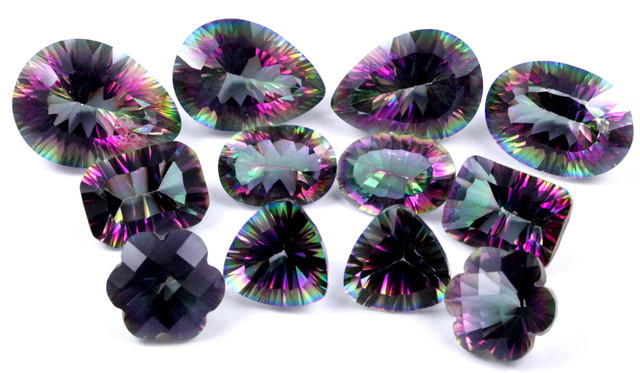
Mystic Quartz Healing Properties
Like its symbolism, mystic quartz’s benefits as a healing stone tie into the powers of clear quartz. Clear quartz is called the “Master Healer,” and is popularly used for balancing and cleansing. It’s touted to heal virtually any ailment.
Mystic quartz as a chakra stone aligns and balances all seven energy centers (chakras), allowing energy and light to flow freely through you. This brings balance to your entire spiritual, physical, and emotional being.
Physical Healing
Physically, mystic quartz is said to treat or help with issues related to:
Fatigue
Immune system function
Balance
Detoxification
Memory
Concentration
Emotional Healing
Emotionally, mystic quartz is said to help you recover from past emotional pain and learn to trust again. It can also assist with manifesting desires, and crystal healers recommend wearing mystic quartz jewelry to help you radiate positive, loving energy wherever you go.

Mystic Quartz Gemstone Properties
Mystic quartz value comes down to many of the same standard factors as most gems. The primary difference is that most gems will be lower-value if treated, which clearly isn’t the case with mystic quartz.
Treatments: How Mystic Quartz is Made
The treatment behind mystic quartz’s appearance involves titanium and a process called Chemical Vapor Deposition (or CVD). Oftentimes, this treatment is applied to the pavilion of a faceted quartz — the pavilion is the lower area of the stone (above the stone’s bottom point and below the crown, girdle, and table).
In short, the titanium is heated so high, it vaporizes, allowing it to be deposited onto the quartz, molecularly bonding to the surface. The result is a super thin layer of titanium on the stone’s surface that reflects light in an iridescent manner.
If you’re worried about any toxicity or environmental damage, Azotic LLC states that “all Mystic® enhancements by Azotic® are created utilizing only green, environmentally friendly processes that DO NOT use radiation or harsh chemicals.”
Color
Mystic quartz can display a rainbow of colors, though cool hues (blues, purples, and greens) are usually most dominant. Like any iridescent stone, though, a full spectrum of colors is more valuable.
Cut
Most mystic quartz stones are faceted before being treated, so the coating can be applied to the pavilion. However, you may see mystic quartz cabochons, which are less pricey but also sparkle less. Mystic quartz carvings are also available.
Clarity
Clear quartz has a Type II colored gemstone clarity grade, so minor visible inclusions are expected, even in mystic quartz. Quartz can have dozens of different inclusions, but common ones in mystic quartz are healed fractures or liquid inclusions.
Like most gems, fewer visible inclusions means higher value.
Inclusions enter the stone during formation, which brings us to our next topic.
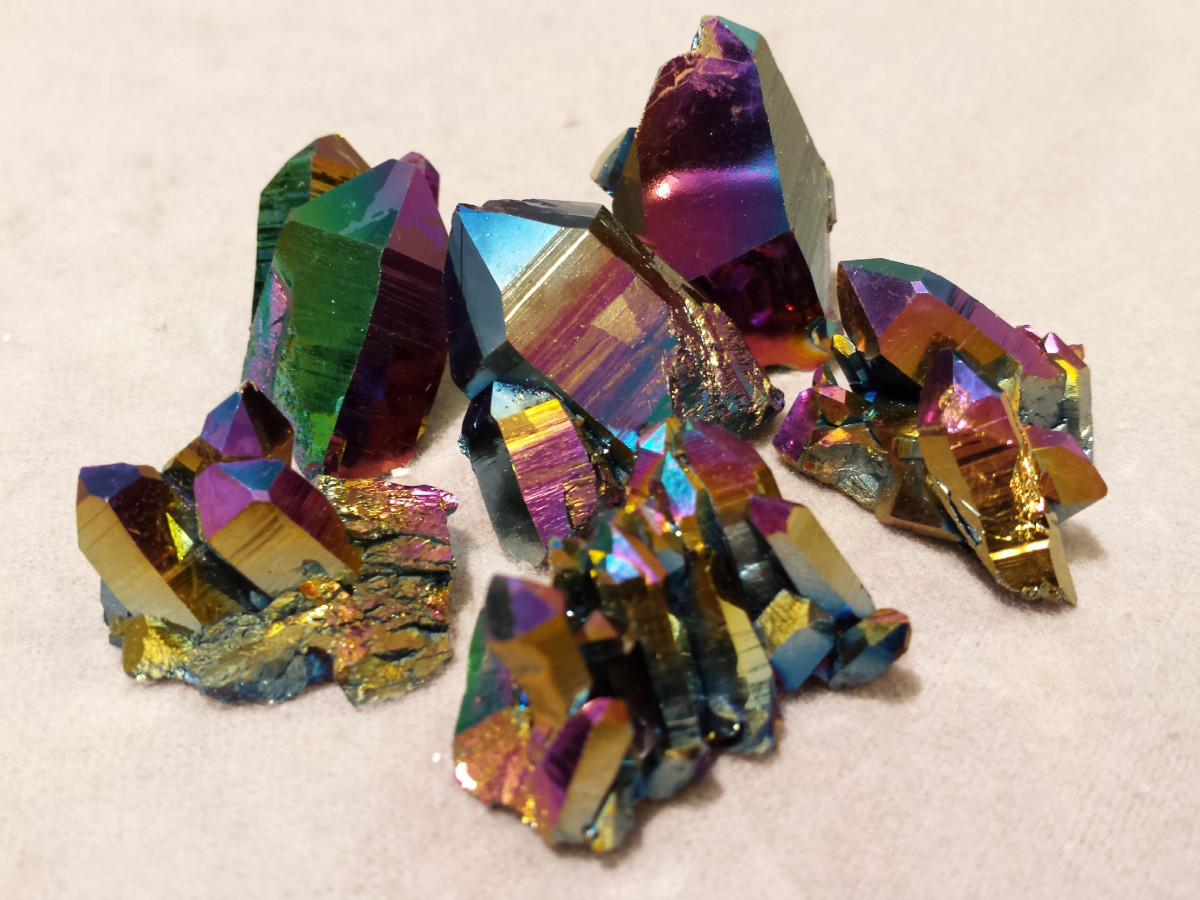
Mystic Quartz Formation & Sources
Mystic quartz doesn’t come out looking iridescent, but clear quartz does form naturally.
Clear quartz grows deep inside the Earth’s crust when traces of silicon and oxygen are present. As boiling magma cools and hardens into rock, clear quartz begins to crystallize from dissolved silica carried by water that settles into the rock’s crevices.
The clear quartz stone usually forms in pegmatites. Clear quartz also forms in igneous, metamorphic, and sedimentary rocks.
Mining Locations
Clear quartz is abundant and found all over the world. That said, significant sources of clear quartz include:
Brazil
Madagascar
Spain
Switzerland
United Kingdom
USA (North Carolina)
Of course, price is a huge buying factor.

Mystic Quartz Price & Value
While clear quartz is super affordable, mystic quartz prices are generally higher. The prices vary broadly, though.
Faceted mystic quartz gemstones range from $10 to upwards of $1,100 at wholesale sites like Gem Rock Auctions. Mystic quartz cabochons are significantly lower, only reaching around $20.
The price of mystic quartz jewelry can depend on the type of metal used for the settings and any other gemstones added. Generally, you’ll find mystic quartz jewelry starting at $20 and reaching just above $200 at wholesale sites like Jewelry Auctioned.
Mystic Quartz Care and Maintenance
For treated stones like mystic quartz, proper gemstone care is crucial. Verified mystic quartz stones treated by Azotic LLC have a permanent, stable coating, but they’re still vulnerable to damage.
Do NOT use abrasive cloths or any other polishing/buffing tools on mystic quartz. Also keep it away from:
Harsh chemicals (e.g. acids, bleach)
Mechanical cleaners (e.g. ultrasonic or steam)
High heat
To safely clean mystic quartz, you can gently wipe it down with a dry, dust-free, microfiber cloth. You can also rinse it with lukewarm water; just be sure to dry it afterwards to avoid water stains on the coating.
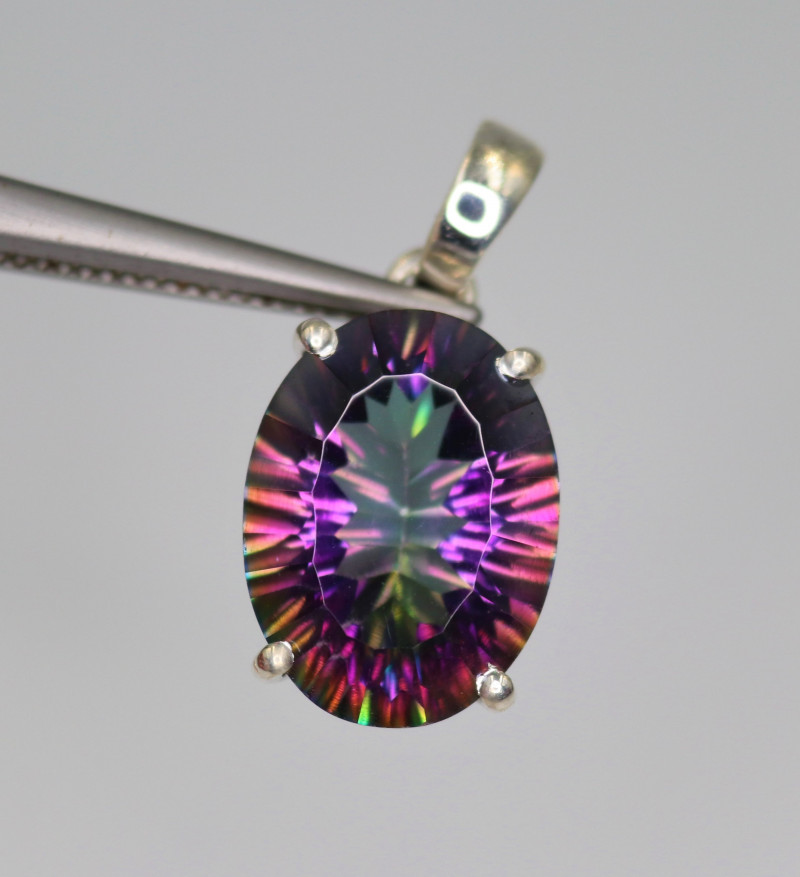
Mesmerized by Mystic Quartz?
In hard times, everyone could use a bit of color and vibrance to lift their spirits. Mystic quartz is the perfect way to bring some brightness and joy to your look, with price ranges accessible to everyone!
Search the Gemstone Encyclopedia
Related Auctions
Related Articles
Originally the Birthstones or gemstones were associated with a zodiac sign or the month of a individuals birth. Find out what your stone is and view the stones we have for sale
8th Feb 2021
Azotic treatment of Topaz and Quartz is a treatment that creates a layer of color over a gemstone. Learn more about this treatment and check out our stones fro sale.
8th May 2018
There are dozens of quartz and chalcedony gems with various colors and patterns. Learn all about quartz properties and every type of quartz, from amethyst and agate to plasma and phantom quartz!
15th Oct 2020
Latest Articles
Tantalite is a group of red, brown, or black minerals containing the rare and valuable element tantalum. Discover the uses, history, prices, and properties of tantalite gemstones in this guide!
11th Nov 2024
Hodgkinsonite is a very rare collector’s gemstone known for its vibrant pink or purple hues, only found in New Jersey, USA. Learn hodgkinsonite’s prices, history, properties, and traits in this guide!
9th Jun 2024
Canasite is a rare mineral usually found as greenish-yellow inclusions in charoite but also known as a purple gemstone. Learn canasite’s history, varieties, properties, and prices in this guide.
27th May 2024
Article Categories
How To's is where you will find helpful articles from gem Rock Auctions on how to cut gemstones, select gemstones and buy gemstones.
9 Articles





